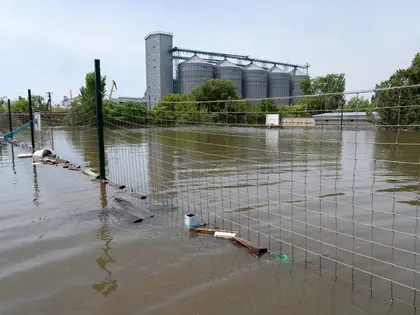The environmental destruction wreaked by the destruction of the Kakhovka dam will be the second-largest ecological disaster inflicted on Europe for 70 years, experts have told Kyiv Post, surpassed only by that caused by the meltdown of the Chornobyl reactor in 1986.
As the flood waters recede in the Kherson region, specialists are beginning to get a clearer picture of an increasingly bleak situation.
JOIN US ON TELEGRAM
Follow our coverage of the war on the @Kyivpost_official.
"The destruction of the Kakhovka Dam by the Russians is the largest disaster of the last 50 or even 70 years - not only in Ukraine but also in Europe. That is, except for the Chornobyl disaster," Oleh Lystopad, an ecologist of the National Interests Advocacy Network (ANTS), told Kyiv Post.
Black Sea in danger
Mykhailo Khorev, the former Deputy Minister for Environmental Protection and Natural Resources of Ukraine, told Kyiv Post the Black Sea will suffer horribly from the pollution caused by the disaster.
River water, polluted with petroleum products and lubricants will flow into the sea along with the waste from destroyed sewage systems and cesspools, organic residues from fertilizers and other chemicals, not to mention landmines and other ammunition that could detonate in the water.
"The biggest risk factor is that this water dislodged and washed away a huge amount of garbage from approximately 15 hectares of domestic landfills, he said. “The [unanswered] question is how toxic that is.”

South Korea Demands 'Immediate Withdrawal' of North Korean Troops in Russia
“We need to do additional testing for herbicides and pesticides, to check whether there is an excess of toxic substances from mineral fertilizers because these substances can kill fish and other living organisms.”
Another factor is the large amount of freshwater heading to the sea, which will also impact the environment. Oleh Lystopad, an ecologist, said large amounts of polluted fresh water during a hot summer can lead to extensive growth of algae and other microorganisms in the sea, which will result in algal blooms in marine water.
The territorial waters of other countries of the Black Sea Basin may be impacted as well. To fully comprehend the magnitude of the ecological threat, experts require more in-depth analysis of water samples.
Drinking water crisis
"The [drinking water] wells people were using are also flooded, and when the floodwater recedes, no one knows what will end up in those wells. Therefore, these wells must be pumped out and disinfected as soon as possible. We will have to wait for them to fill up again and check the quality of the water," Lystopad said.
Also, he says, the quality of the water in the Dnipro will go down: “We will probably have to add more reagents, like aluminum and chlorine."
The explosion of the Kakhovka Dam resulted in the mass death of animals, birds, and fish. While there was touching footage of pets being rescued from the flooded area but, for smaller domestic and wild animals, the flood meant death.
"Even if the water level is low, even if it is only half a meter, it means death for small animals,” Lystopad said. “Hedgehogs, different types of rodents, anything that does not have enough time to escape - they will all die.
“A lot of animals will die, including very rare species. There are habitats, territories where endemic wild life lives, types that are not found anywhere else."
Forests in the Kherson region were also affected by the floods. The Association of Foresters of Ukraine reports that approximately 55,000 hectares of forests have been flooded, of which 47,000 hectares are in the occupied territory.
Where there are floods, water causes the development of root rot and changes the acidity of the soil. If the water remains there for up to 20 days or more, it can kill the trees.
Climate change
In the future, Ukraine risks having a new desert with all the side effects that come hand in hand, such as a decrease in precipitation, dust storms, soil erosion and temperature increases.
"When these soils dry out, there will be sand deposits. And with strong winds, there will be sandstorms. The climate will change to a drier one," Lystopad says.
Experts explain that Ukraine needs time to comprehend the full scale of this ecological disaster. However, to fully assess the damage, it is imperative that the water recedes and the left bank of South Ukraine be liberated.
Ukraine’s experts add that the European community should pay attention to this large-scale ecocide because it will affect not only Ukraine but also many neighboring countries.
You can also highlight the text and press Ctrl + Enter






